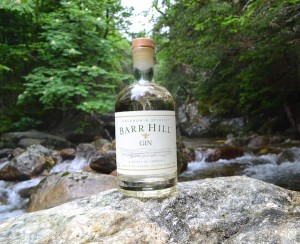 Ascending to the Lakes of the Clouds hut, at the foot of Mt. Washington
Ascending to the Lakes of the Clouds hut, at the foot of Mt. Washington
On July 4, Justin was feeling very patriotic, and in honor of our first president, filled his backpack with a 750 mL of Barr Hill gin and began the ascent to the Lakes of the Clouds Hut, perched on the side of Mt. Washington, which is the highest peak in the Northeast and is named after George Washington. The gin was a gift for the crew, those who caretake these huts for hikers in the old and continuing tradition of mountain hospitality.
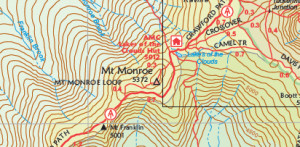
The Ammonoosuc Ravine Trail follows the Ammonoosuc River some of the way for the 3.1 miles from the parking lot to the Lakes of the Clouds hut.
all photos by Justin Gellert
We found the cairns placed above the tree line to be very important as guides on the trail in the fog and rain, and well as inspiration on the sunny days. Old cairns are found on the trails in the high mountains of Scotland and also at Caledonia Spirits in Hardwick.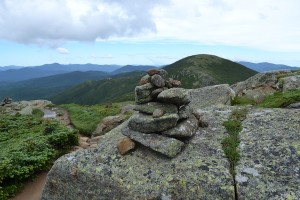
Inspired by the hut system of the Alps where one can hike from hut to hut and get meals, lodging, and shelter from the elements, the huts of the Appalachian Mountain Club go back 100 years. We started our hike at the Highland Lodge parking lot, only 1.25 hours from Caledonia Spirits in Hardwick. Being located in the Northeast Kingdom of Vermont, we are very close to the White Mountains of New Hampshire. These are some of our sacred places, the mountains that we first hiked together as a family when our youngest was only 6. We always thought it was cool to skip out of school early on a Friday afternoon and drive to the White Mountains and hike into a hut for dinner. The beauty a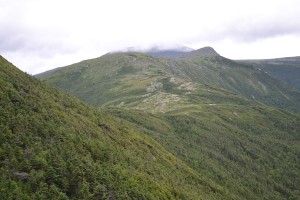 nd glory of the northern summer are truly evident in the high places of these mountains.
nd glory of the northern summer are truly evident in the high places of these mountains.
We are on the Crawford Path (oldest continuously maintained mountain trail in the USA, built in 1819) from Lakes of the Clouds hut to Crawford Notch, a rugged 7-mile downhill path, where the winds reached 80 – 90 miles on the summit the night of July 4; still very windy the next day.
The Appalachian Mountain Club was founded in 1876, and built its first trail up Tuckerman Ravine of Mt. Washington in 1879 and its first hut at Madison Spring in 1888. In 1911 the AMC advocated with other groups for the passage of the Weeks Act, which authorized the creation of the Eastern National Forests.
www.outdoors.org
join our new challenge!
Send us stories and pictures of your adventures in the special & inspirational places of the world, and include a Caledonia Spirits bottle in the photo. Give us a little history, color, and information on how we may learn more about this sacred earth. If your story is chosen for the next newsletter, we will send or deliver a case of Caledonia Spirits raw honey to your address in the United States, Quebec, or Ontario. Send your photos and stories to todd@caledoniaspirits.com .
Live from the hive: The making of a queen
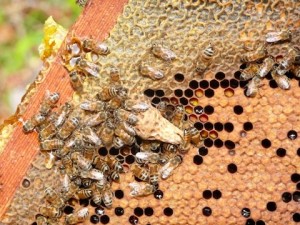 In this picture you see a “queen cup” — an elongated cell, looking a bit like an ice cream cone, that contains a queen bee larva. The bees are making a new queen, which they do when the queen dies, is failing, or has left the hive with a swarm. A fertilized egg develops into a queen when the workers feed a fertilized egg with a rich food made of honey, pollen, and enzymes, called Royal Jelly. Because she will be a very large bee, she needs a larger cell to grow in.
In this picture you see a “queen cup” — an elongated cell, looking a bit like an ice cream cone, that contains a queen bee larva. The bees are making a new queen, which they do when the queen dies, is failing, or has left the hive with a swarm. A fertilized egg develops into a queen when the workers feed a fertilized egg with a rich food made of honey, pollen, and enzymes, called Royal Jelly. Because she will be a very large bee, she needs a larger cell to grow in.
The queen bee is born with all of the eggs she’ll ever lay in her extra-long abdomen. Once she has mated she deposits one tiny white egg in each cell of honey comb at the rate of up to 2,000 eggs a day at the peak of the spring buildup. But this egg laying is tied to the sun, seasons, and length of the day. The summer solstice having passed on June 21, the queen has begun to slow down in preparation for winter.
The slightly convex cells at the top of the picture are capped honey cells, while the reddish brown, slightly puffy cells further down contain larvae. The uncapped yellow cells contain pollen. Note the “courtier” bees who are tending the queen cell.
The queen bee is just another example of the miracle of the bees and the perfection exhibited in their life cycle.
– Annie Watson, Thistle Hill Studio